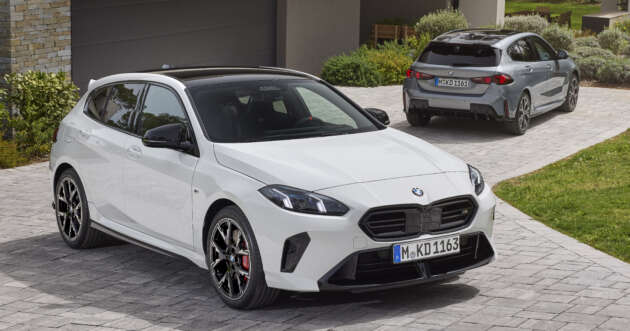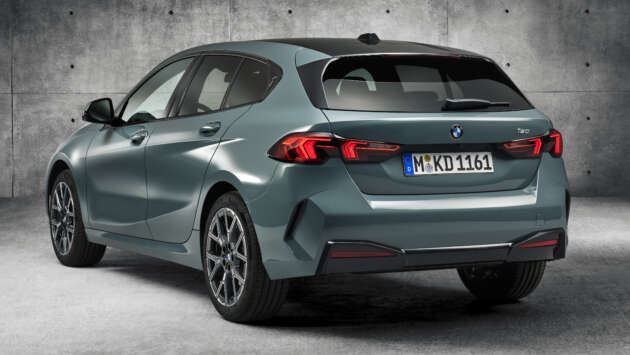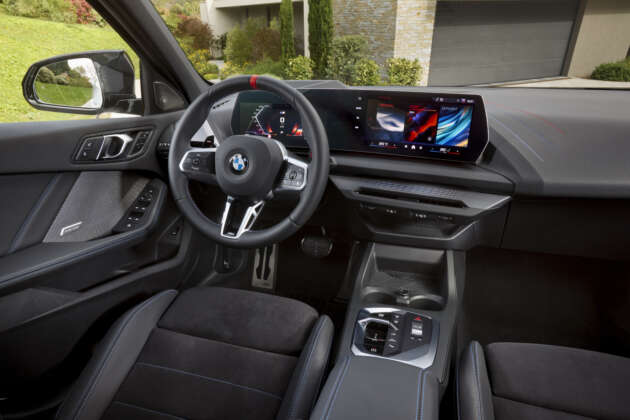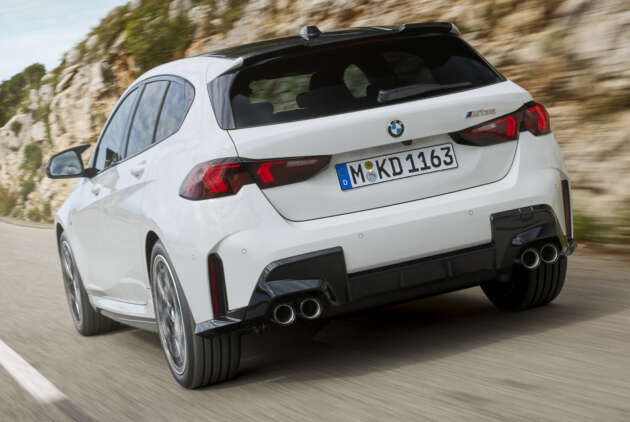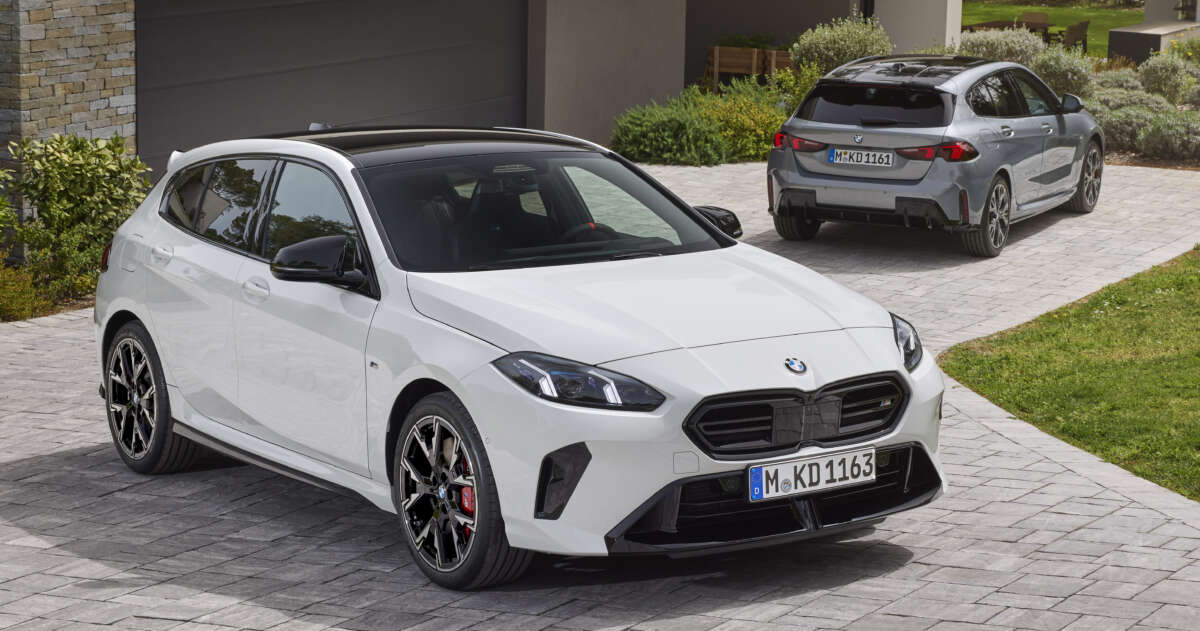
The BMW 1 Series has entered its fourth generation with the reveal of the new F70 model. The second iteration to be based on Munich’s front-wheel-drive architecture (FAAR), it’s actually a heavy facelift of the slightly milquetoast F40 predecessor, following in the footsteps of its F66 MINI Cooper stablemate while adding new technologies seen on the brand’s other recent cars.
The similarities to last model start with the dimensions, where the new 1 Series retains the 1,800 mm width and 2,670 wheelbase, albeit with a 42 mm increase in length and a commensurate 25 mm bump in height to 4,361 mm and 1,459 mm respectively. It also carries over a surprising amount of styling hallmarks from the old car, including the long bonnet, cab-backward profile, wide taillights and even the almond-shaped headlights.
The design has at least been usefully sharpened up, with details such as the vertical daytime running lights (blue-tinged adaptive matrix LED headlights are optional) and a conjoined double kidney grille (now with a bizarre mix of vertical and diagonal slats) that’s wider and mounted much lower, eliminating the outgoing model’s pig-nosed look.
So much is shared with the F40 that even the doors are identical, retaining that car’s pull-type door handles (all other new BMWs feature flush handles with an upper flap). However, the C-pillar appliqué has been extended to enhance the Hofmeister kink graphic and now incorporates an embossed “1”, similar to the “5” on the latest G60 5 Series.
Elsewhere, you can now option the 1 Series with a black roof for the first time, while the “fanged” taillights with their hexagonal graphics take inspiration from the new U10 X2. The standard 1 Series gets a wide front air intake, vertical front and rear corner inlets and an already sizeable diffuser, the latter being supersized on the M Sport version that also incorporates the split downturned front intake from the X2.
Just like the outside, much of the interior has been left unchanged, including the door cards. Freshening up things somewhat is a new dashboard and centre console, featuring distinctive horizontal slots for the corner air vents, “hidden” centre vents and a stubby gear selector toggle. The curved widescreen display panel will be familiar to those who own BMW’s other new compact cars, fitted with a 10.25-inch digital instrument display and a 10.7-inch infotainment touchscreen, separated by a column of touch-sensitive shortcut buttons.
The tech runs on the latest Android-based BMW Operating System 9, a fully touch-based interface that ditches the iDrive rotary controller and incorporates the air-con controls in the centre screen. A three-spoke steering wheel comes as standard, with the M Sport package adding a racier ‘wheel with cutouts in the centre spoke, plus the M tricolour in the ambient lighting and dashboard stitching.
Elsewhere, you get redesigned seats which can be replaced by either sport or M Sport seats, as well as either Econeer fabric (made from recycled PET bottles) or Veganza faux leather upholstery. Also new is a standard front centre airbag and an optional massage function. As before, you get a 380 litre boot, expandable to 1,200 litres by folding the rear seats.
At launch, the new 1 Series will be offered in two petrol and diesel variants, the former being the first BMW petrol models to ditch the “i” suffix. A 150 PS/360 Nm 2.0 litre B47 four-cylinder turbodiesel powers the 118d and 120d, the latter gaining a 48-volt mild hybrid system that pushes outputs to 163 PS and 400 Nm of torque. The same mild hybrid system augments the 156 PS/240 Nm 1.5 litre B38 turbocharged three-cylinder petrol engine in the 120, leading to a total system output of 170 PS and 280 Nm.
Sitting at the top of the range is the all-wheel-drive M135 xDrive, motivated by a 2.0 litre B48 turbo petrol four-pot making 300 PS and 400 Nm – enough to get the hot hatch from zero to 100 km/h in 4.9 seconds. All engines are now mated to a seven-speed wet dual-clutch transmission, ditching the old eight-speed Aisin automatic and six-speed manual options.
Under the skin, the 1 Series benefits from a stiffer body structure and a revised chassis that features new suspension geometry (including a 20% greater caster angle at the front for increased stability and steering feedback), preloaded anti-roll bar mounts and revised dampers.
A brake-by-wire system has also been added, while sport steering, adaptive dampers and larger brakes can be fitted by opting for the M Sport package that’s standard on the M135. The latter is further set apart by horizontal grille slats, M side mirror caps and quad tailpipes; you can also spec the car with an M Technology Package that throws on uprated suspension components, M Compound brakes and 19-inch forged alloy wheels.
Safety-wise, the 1 Series has been boosted with an array of driver assists, including the Driving Assistant package (adding autonomous emergency braking, lane departure warning, a door opening warning and traffic sign recognition) and Parking Assist with reversing assist that are now part of the standard specification.
On the options list is the Driving Assistant Professional that adds adaptive cruise control with stop and go, lane centring assist and speed limit assist, while the Parking Assist Professional enables remote park assist.
GALLERY: F70 BMW M135 xDrive
Looking to sell your car? Sell it with Carro.

